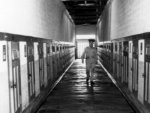Old Chiayi Prison after World War II
(Administration Center and central transmitting station's line of defense.)
(picture source:photo by this team.)
Soon after the Retrocession of Taiwan, the regime change accentuated cultural conflict. In order to make people feel that they have been freed from Japanese rule, the Nationalist government often used the tactic of "changing names" to legitimize itself; Chiayi Office was renamed to "the First Branch Prison of Taiwan Third Prison," and in 1947 the "Taiwan Chiayi Prison" was established.
In 1994, in order to accommodate the plans for prison improvement by the Ministry of Justice, in hopes of improving the living standards of convicts, the location f the Chiayi Prison was moved to Lutsao Township in Chiayi County, and the older location was changed to the Chiayi Branch Prison. In 1996, in response to the issue of urban renewal, it faced latent obstacles of whether to demolish or preserve. It was visited by the former Minister of Justic Liao Cheng-hao, who proclaimed the plan to establish a prison museum.
1998 Chiayi City Government submitted its proposal to the Ministry of Justice to apply for the free usage of land at the Old Chiayi Prison to be used by Chiayi University. In September the Ministry of Justice responded that it could not do this, and in October, Chiayi City Government held an evaluation meeting of the historical monument, in which scholars had a consensus about the preservation value, and the meeting temporarily established the prison as a historical monument.
(The appearance of the cell for women interview room.)
(picture source:photo by this team.)
In 1999, Chiayi City Government used the "proposal to fully re-evaluate changing the urbanization plan" to re-designate the land at the old address of the Old Chiayi Prison as usable by Chinese Cultural University; the Old Chiayi Prison objected. In September of the same year, the Chiayi Prison appointed its vice warden and related personnel to be present to make its demurral.
In 2002, the "team for the promotion of preservation and reuse of the Chiayi Old Prison" and Tainan's "team for the promotion of Tainan Judicial Museum" allied with other legal reform organizations to promote the Old Prison as a cultural and historical asset of Taiwan's legal governance and academic groups. June of the same year, Chiayi City Government designated Old Chiayi Prison as a city historical monument.

(The aisle of the cell block.)
(picture source:Provide by Mr. Sianyi Chen.)
In May 2005, the Department of the Interior declared with Taiwan-Interior-Civil No. 09400612862 promulgation that Chiayi Prison was now ranked as a national historical monument. In November, Minister of Justice Shih Mao-lin toured the prison, and ordered plans be made for the "prison historical museum." Contacts were made with the Professor Liu Chuan-chi at the National Yunlin University of Science and Technology to establish the museum with the help of cultural and literary workers; their professional information was used to begin fieldwork-related investigations.
In 2006, Old Chiayi Prison made contact with leader of the exhibition team, Mr. Lin, at the National Palace Museum, to plan various operations and data collection. Mr. Lin Chih-hao, in charge of Bengang Cultural Works, Co. Ltd., was also enlisted to assist in planning and maintenance work. A meeting was held at the convention room of the Old Prison to discuss issues of maintenance and usage of "National Historical Monument - Old Chiayi Prison" as well as other issues. Late June of the same year, the Old Prison was cleaned up for the event "Understanding Historical Monuments" held in conjunction with the Council of Cultural Affairs, and the "National Historical Monument - Old Chiayi Prison" was opened to the public.
Source:
-
Researched and organized by this team
-
Planning and Research Report on Renovation and Reuse of the Old Chiayi Prison as A Historical Monument of Chiayi City
-
Nanhua University Master's thesis: Construction of Three Dimensions in Arenas of Power Study of Chiayi City, Old Chiayi Prison, and the Body
